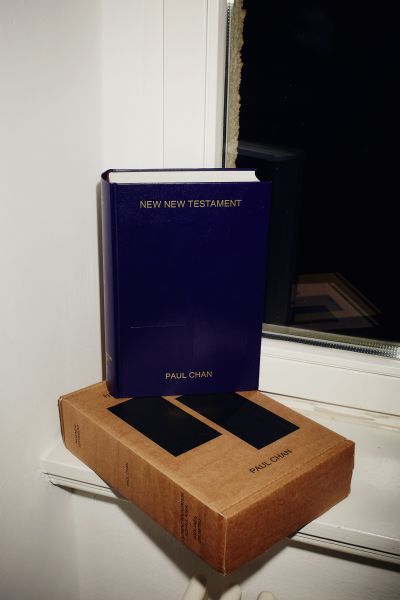Laurenz Foundation, Schaulager, Basel / Badlands Unlimited, New York
Paul Chan. New New Testament
- Kategorie
- Bronze Medal
Begründung der Jury
★★
Switzerland /// Schweiz
★★
Proportions of the book body: comparable to a lectionary. Illustrations on the right-handbook pages: the artist has freed the book jackets from their contents. He uses the opened covers as upright canvases. On these canvases, he paints blunt rectangles, spread out, bluish grey, light to dark, sometimes with a mountain motif—like label tags without titles. Every new picture is meticulously numbered, verse-like, compulsive. The original lines on the spine remain mostly legible. Text on the left-hand pages: each of the numbers is added by a text—coded inconcrete poetry with extended punctuation and syntax, as if directed by a higher force. Back in the baroque age, this principle of apparently knotted semiotics already fired uppensive minds to unravel the meaning of the world in emblematic books. The seriousness of such undertakings is, of course, only guaranteed, if everything is arranged with extreme care and stringency, which means that everything must be above board: perfect proportions, classic type setting in Garamond, precise print. An exegetic attempt: the material side of the testament is its existence as a book. The semantic side is that it is hidden through a code. The art in the book turns the book into art becomes art through the book which produces the art.
★★
Proportion des Buchkörpers: einem Lektionar entsprechend. Abbildungen rechte Buchseiten: Der Künstler hat Bucheinbünde von ihrem Inhalt befreit. Die aufgeklappten Decken benutzt er als hochformatige Leinwände. Darauf malt er stumpfe Rechtecke, flächig, blaugrau, hell bis dunkel, zuweilen mit Bergmotiv – wie Titelschildchen ohne Titel. Jedes neue Bild streng durchnummeriert, versmäßig, zwanghaft. Die ursprünglichen Rückenzeilen bleiben meist lesbar. Text linke Buchseiten: Den Nummern dazugestellt sind je ein Text – chiffriert in konkreter Poesie mit erweiterter Interpunktion und Syntax, wie von einer höheren Macht dirigiert. Dieses Prinzip scheinbar verknoteter Semiotik feuerte schon im Barock nachdenkliche Gemüter an, den Weltsinn in den emblematischen Büchern zu enträtseln. Die Ernsthaftigkeit solcher Unternehmen ist freilich nur gewährleistet, wenn alles mit größter Sorgfalt und Stringenz angelegt ist, das heißt mit rechten Dingen zugeht: perfekte Proportionen, klassischer Satz aus der Garamond, präziser Druck. Ein exegetischer Versuch: Die materielle Seite am Testament ist sein Dasein als Buch. Die semantische Seite ist sein Verstecktsein als Code. Die Kunst im Buch macht das Buch zur Kunst wird zur Kunst durch das Buch macht die Kunst.

